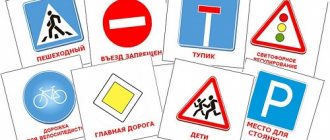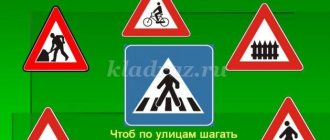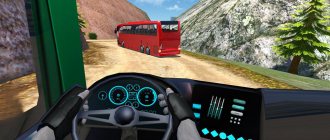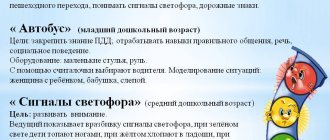MAGAZINE Preschooler.RF
Leisure summary on traffic rules in the preparatory group. Topic: “On the street - not in the room. Remember that guys"DEPARTMENT OF EDUCATION OF THE CITY OF MOSCOW South-Eastern District Department of Education of the City of Moscow
GBOU secondary school No. 2051 “Pedagogical complex”
The summary was compiled by the preparatory group teacher Natalya Nikolaevna Ratova
The leisure time was prepared and conducted by teachers of the preparatory group: Galtseva Elena Aleksandrovna Ratova Natalya Nikolaevna Moscow, April 2015.
Program content:
1. Continue to become familiar with the rules of the road, road signs and their purpose, and markings. To form an idea of the work of a traffic controller and his functions.
To consolidate knowledge of the rules of safe road traffic as a pedestrian and a passenger in a vehicle. To consolidate knowledge about special transport, the ability to recognize different types of special transport.
2. To develop the ability of children to communicate with adults and peers on familiar topics and exchange information.
Continue work on enriching children's vocabulary with words: traffic controller, markings, baton, special transport; activate children's vocabulary: rules, transport, traffic lights, etc.
Strengthen the ability to read a poem expressively, answer questions with both full and short answers. Continue to develop the ability to meaningfully and emotionally talk about interesting facts and events.
3 Raising children - being good pedestrians and drivers, a careful and prudent attitude towards potentially dangerous situations on the street.
Preliminary work: conducting educational activities on traffic rules “My friend traffic light” , “Rules for crossing the street” , watching with children a fragment of the film “Let’s save the most valuable” (winner of the “Naukograd” ), cartoons “Smeshariki and traffic rules” , reading fiction about traffic rules, didactic games to familiarize yourself with road signs (“Guess which sign”, “Traffic light”, “Drivers”, “Road signs”, etc.), looking at illustrations of various vehicles, memorizing poems and guessing riddles about road signs, conversations about the rules of safe behavior on the street and in public transport.
Materials and equipment: model of road markings, models of houses, trees, sidewalks with a painted zebra (pedestrian crossing), model of a traffic light, traffic signs. Yellow, red, green circles, steering wheels, cars with strings, landmarks, Zebra , cut-out pictures of Road Signs .
Leisure activities:
The hall is decorated with a model of road markings, models of houses and trees, sidewalks with a painted zebra, a model of a traffic light, and traffic signs.
Children enter to the music (Collection “Songs for Children” ) of the traffic rules “This world consists of pedestrians . Children sit on banquettes.
Educator: A long time ago, when there were no cars or traffic rules, and people moved on foot or on horseback, going on a long journey, they took a weapon and a shield with them - you never know who you’ll meet on the road. And, if two warriors met on a narrow path, each of them retreated to the right to let the other pass and shield himself from the stranger with a shield in his left hand. This is how the first rule appeared - move on the right side.
As the years passed, a lot of cars appeared on the roads, people came up with rules for those who walk and for those who drive.
Guys, we live in a big, beautiful city with wide streets and avenues. Many cars and trucks, trams, buses move along them and no one bothers anyone. This is because there are clear and strict rules for drivers and pedestrians. How many of you know what these rules are called? - that's right, Traffic Rules. Today we will talk a lot about traffic rules, and not only talk, but play, sing, learn the stories of traffic rules. But before we begin, I want to introduce you to our guest.
A traffic police inspector came to visit us. He wants to get to know you and test your knowledge of the rules of the road.
Traffic police inspector:
Hello our little pedestrians. As you know, there are a lot of cars moving on the streets and roads, and if you don’t know the rules of the road, you can get into trouble. Do you all know these rules?
(Children's answers).
Let's get a look:
-What do you call people walking down the street? (Pedestrians).
– Where can I cross the street? (By transitions).
What should you do before crossing the street? (Look - left, go to the middle of the road - look to the right, then walk the rest of the distance).
– Why is it dangerous to cross the street? (Because in addition to pedestrians, there are also cars on the streets).
Traffic police inspector:
Well done boys! You know the rules of the road well.
Do you know how to solve riddles? I want to tell you a riddle:
He stands on the road, He leads everyone. Answer in unison, in unison He is called... /traffic light/
Educator: (shows a layout of a traffic light)
What is a traffic light for?
Children: A traffic light is needed to regulate traffic so that there is order on the streets and roads.
Educator: What does each traffic light signal mean?
Child: For example, the guys know that the traffic light is a friend to you and me. He turns on the red light, so you stand still.
Child: The yellow light warns that there is no way as before! Only the green one allows us to cross the road.
I'm glad to hear the traffic light. This song is for the guys.
Everyone sings the song “Traffic Light” . A. Sultanova, lyrics. Z. Ilyina.
Educator: Guys, do you know who and when invented the traffic light? And so the first story: “The History of a Traffic Light” (parents’ report “The History of a Traffic Light” , with the presentation of a homemade book).
Physical education teacher: (The presenter shows colored circles, at the signal of which you need to perform certain movements: green - stomp; yellow - clap; red - stand quietly. The presenter praises them)
Traffic police inspector: Guys, I came to visit you not alone, but with my assistants holding road signs (Children stand next to the inspector and hold traffic signs in their hands). Road signs are needed so that the street can “talk” to drivers and pedestrians in a language they understand. Wherever you go, there are road signs on the streets. They are of different colors and different shapes. This is no accident. You need to be able to understand the language of the street - the language of signs. Now you go to kindergarten with your parents, and next year you will go to school, and you will have to walk the streets and cross the road on your own.
You need to know a lot of rules. Please tell me about the signs!
7. Child: (with a sign “Pedestrian crossing” )
Here is a pedestrian crossing and people are walking along it. Cars will slow down here and let adults and children through.
8. Child: Useful for pedestrians to know the designation of crossings, in order to choose the right and straight Path to the garden, square and home.
9. Child: (with a sign “Pedestrian traffic is prohibited” )
You can see a sign like this on a highway, where there is a large hole, and it’s dangerous to walk straight,
Where a district is being built, a school, a house or a stadium.
10. Child: (with a sign “Medical aid station” )
If you have a headache on the road, this sign will save you - Help will come on time!
11. Child: (with a sign “Food station” )
Here's the fork, here's the spoon! Let's refuel a little. We fed the dog too. We say “thank you” to the sign.
12. Child: (with the sign “Caution, children!”
All the engines quiet down, And the drivers are attentive, If the signs say: “Close to a school, kindergarten .
13. Child: (with a “No Entry” )
It’s a round sign, and there’s a window in it. Don’t rush here rashly, but think a little: What’s here? Brick dump?
No! This sign says that cars are not allowed to enter. Inspector: Understand these signs, Don’t get lost on the road.
Concluding the speech, Let us summarize the teaching. In short, everyone needs to know the rules.
No matter who you are, old or young, knowledge of the rules is a valuable treasure. I thank you all personally. You did an excellent job!
Game “Who is faster”
(Everyone is divided into 4 groups of 3-4 people. From the cut parts you need to put together 2-3 signs. The team that assembles the picture with the signs first and correctly wins)
Educator: There are emergency situations, or when the traffic light does not work for some reason. What do you guys think, who will come to the rescue and help you follow the traffic rules? (Children's answers) That's right, the first assistant and the most important person on the road is a traffic controller or a guard.
Child:
Look, the guard stood on our pavement, quickly extended his hand, deftly waved his wand.
Have you seen it? Have you seen it? All the cars stopped at once! They stood together in three rows and didn’t go anywhere!
People don't worry, they're walking across the street. And he stands on the pavement, Like a guard guard.
All machines obey one.
(Ya. Pishumov)
Educator: The traffic police inspector regulates the movement of vehicles and pedestrians. He has a black and white stick in his hand. What is it called?
Children: Rod.
Educator: The inspector either lifts him up, then lowers him down, then takes him to the side, turning his face, back or side towards us. Let's remember what all these movements mean.
The inspector tells and shows the meaning of the traffic controller's gestures.
If the traffic controller stands with his chest or back to the vehicle or pedestrians
movement towards the chest and back is prohibited. This corresponds to a red traffic light
The traffic controller raised his rod up in front of him:
attention! This corresponds to a yellow traffic light
If the traffic controller stands sideways to the vehicle or pedestrians -
this corresponds to a green traffic light: you can go, go.
Several children are invited and the game “Traffic Controller” . Some children are in the role of pedestrians, others are in the role of drivers.
The inspector praises and thanks the children. Well done! You did well. I wish you to be competent pedestrians and always follow traffic rules. Pays attention to the “Pedestrian Crossing” or “Zebra” , asks the question “How should you cross the road?” , “What is a pedestrian crossing? Zebra?" (Tells what a pedestrian crossing is or a “Zebra” is a road marking).
Educator: Guys, let us now listen to the story “The History of Road Markings” (a report from parents presenting a homemade book).
Game “Adroit Driver” (2-3 times) or relay race
(Two children are playing; the players, without knocking over the pins, must move toy cars between them by a string)
Educator: Guys, let's listen to one more story now. And so the story “The Story of a Traffic Controller” (a report from parents with the presentation of a homemade book).
Educator: How diverse the transport world is! And you guys, of course, know that not a single city can exist without special transport. Let's remember the names of these vehicles. (Children's answers: Ambulances , police, fire, gas service, traffic police, Ministry of Emergency Situations, as well as snow removal and emergency vehicles.)
Inspector: All this transport is used in extreme cases, when you need to rush to help someone. Therefore, special vehicles can violate traffic rules: drive through red lights, drive at high speed with sound and light sirens turned on. Do not rush to cross the road in front of such vehicles, it is better to give way and at the same time be extremely careful.
Game “Modes of Transport” (transport can be fabulous)
Questions:
- What did Emelya ride on to the Tsar’s palace? (on the stove).
- Leopold the cat's favorite mode of transport? (two-wheeled bicycle).
- How did Carlson, who lives on the roof, lubricate his motor? (jam).
- What gift did Uncle Fyodor's parents give to postman Pechkin? (bike).
- What did the Good Fairy turn the pumpkin into for Cinderella? (into the carriage).
- What did Old Man Hottabych fly on? (on a magic carpet).
- Baba Yaga's personal transport? (mortar).
- What did Kai ride on from the fairy tale “The Snow Queen”? (sledging).
- Bears were riding a bicycle, and behind them was a cat backwards, and behind him mosquitoes... (on a balloon).
- What did Baron Munchausen fly on? (on a cannonball).
Game “Fast Driver”
(Two children are playing; players need to wind a string as quickly as possible around a pencil to which a toy car is tied.
Educator: Guys, let's listen to the last story now. And so the story “History of Special Transport” (parents’ report with the presentation of a homemade book).
Leading. The city in which you and I live can rightfully be compared to an ABC book!
With the alphabet of streets, avenues, roads, the city always gives us a lesson!
Here it is, the alphabet - above your head - signs are hung along the pavement!
Always remember the alphabet of the city so that no trouble happens to you!
1Child: Year after year, five years in a row. We went to kindergarten. We know the traffic rules, and of course we follow them.
And that’s why we’re ready to go to school in September. Inspector: To get to school, you need to cross the road.
2Child: Traffic rules will help us on our way! Inspector: But you often violate traffic rules
And the signs, unfortunately, are quickly forgotten.
3Child: In our kindergarten They taught us everything! How to cross the road, Where to wait for the tram,
What is a sidewalk or pavement? Why was the sign invented? What does it mean?
Inspector: Who answers all the children’s questions?
4Child: Teachers will find time to answer. Inspector: Well, what do the parents do?
Together with the kindergarten, they need to get involved in the work. Then, of course, no misfortunes will happen to the children!
5Child: Who else will teach the children to observe “manners” ? Of course, mom and dad are an example for a preschooler.
6Child: There are many rules in the world, and all the rules are needed. But the road ones for children should still become the main ones.
Children in chorus: Don’t forget to take these rules with you on the road, And they will help you make the path safe!
Inspector: Well done guys! You completed all the tasks well and answered the questions correctly.
Guys, summer is coming soon. And you will spend a lot of time outside. Remember - the roadway is not a place for games. It is very dangerous to play in the wrong places. And remember the Rules of the Road!
To the music of Singing traffic lights - Remember the traffic rules (from a children's musical about traffic rules) - The inspector awards the children with a certificate and presents a memo about traffic rules.
Bibliography.
- E. Ya. Khabibullina “Road alphabet for children in kindergarten” St. Petersburg CHILDHOOD-PRESS 2014
- Compiled by G.D. Belyaevskova, E.A. Martynova, O.N. Sirchenko, E.G. Shamaeva. “Road rules for children 3-7 years old (preschool educational institution: FGT)
Volgograd 2013
3. Saulina T.F. “Three traffic lights” MOSCOW “ENLIGHTENED” 1989 Stepanenkova E.Ya., Filenko M.F. “For preschoolers about the rules of the road” MOSCOW “ENLIGHTED” 1978
4. Authors and compilers: Izvekova N.A., Medvedeva A.F., Polyakova L.B., Fedotova A.N.; edited by Romanova E.A., Malyushkina A.B. Sphere shopping center, 2005
5. Internet resources.
| Next > |






